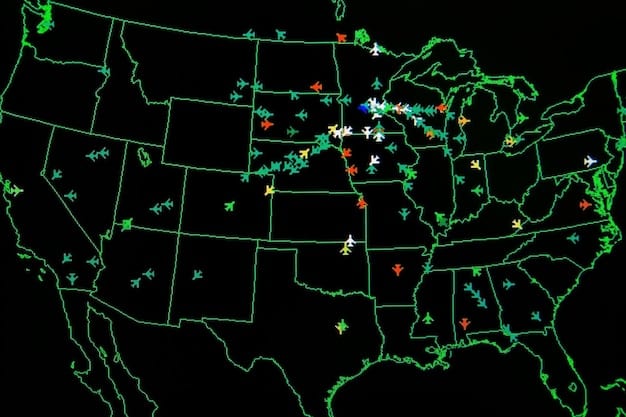Federal Government Extends Emergency Food Assistance Program Through June 2025

The federal government has announced an extension of the Emergency Food Assistance Program (EFAP) through June 2025, ensuring continued support for food banks and pantries across the nation in their efforts to combat food insecurity.
The **federal government announces extension of Emergency Food Assistance Program through June 2025**, providing a crucial lifeline for millions of Americans facing food insecurity.
Understanding the Emergency Food Assistance Program (EFAP)
The Emergency Food Assistance Program, or EFAP, is a federal program designed to supplement the diets of low-income Americans by providing food to food banks and other emergency food providers. Let’s break down the specifics of EFAP and its significance.
EFAP plays a critical role in the fight against hunger in the United States. It provides food and resources to local organizations, enabling them to serve individuals and families in need.
How EFAP Works
EFAP operates through a network of state agencies and local organizations. The USDA provides food to state agencies, who then distribute it to food banks, soup kitchens, and other emergency feeding organizations.
Who Benefits from EFAP?
EFAP benefits a wide range of individuals and families, including those with low incomes, unemployed individuals, and seniors on fixed incomes. It serves as a safety net, ensuring that people have access to nutritious food during times of crisis.
- Provides nutritious food to low-income individuals and families.
- Supports food banks and emergency feeding organizations.
- Helps to alleviate hunger and food insecurity in communities across the country.
EFAP serves as a critical component of the nation’s food safety net, offering essential support to those grappling with food insecurity. EFAP is integral to maintaining food assistance across the United States.

Details of the Extension Through June 2025
The recent announcement of the EFAP extension through June 2025 brings welcome news for those relying on food assistance. This extension ensures that vital resources will continue to be available, aiding food banks in their mission.
With this extension, food banks and other emergency food providers can continue to count on the support they need to serve their communities effectively.
What the Extension Means for Food Banks
For food banks, the extension provides stability and predictability. It allows them to plan for the future, ensuring they can maintain their operations and provide consistent support to those in need.
Impact on Local Communities
The extension of EFAP will have a significant impact on local communities. It helps to reduce food insecurity, improve health outcomes, and support the overall well-being of individuals and families.
- Ensures continued food assistance for vulnerable populations.
- Offers stability for food banks and emergency food providers.
- Helps to strengthen communities by reducing hunger and food insecurity.
By extending EFAP through June 2025, the federal government is reaffirming its commitment to fighting hunger and supporting communities in need. The program remains a central pillar in addressing the challenges of food insecurity.
The Importance of Emergency Food Assistance
Emergency food assistance programs like EFAP are crucial for addressing immediate food needs during crises. These programs provide a safety net for individuals and families facing unexpected hardships.
The significance of emergency food assistance extends beyond just providing meals. It offers a crucial lifeline for those who, without it, might struggle to meet their most basic needs.
Addressing Immediate Needs
Emergency food assistance programs are often the first line of defense for individuals and families facing sudden job loss, medical emergencies, or other unexpected setbacks.
Supporting Vulnerable Populations
These programs are especially important for vulnerable populations, such as seniors, children, and individuals with disabilities, who may be particularly susceptible to food insecurity.
Emergency food assistance serves a vital role in stabilizing communities during times of economic uncertainty. It helps prevent hunger and malnutrition, ensuring individuals can maintain their health and well-being.
How the Extension Impacts Different States
The impacts of the EFAP extension will vary across different states, depending on factors such as population size, poverty rates, and the strength of local food bank networks. It’s important to understand the nuances of how the extension will play out at the state level.
For some states, the extension will mean a continuation of existing benefits, while for others, it may allow for increased support to meet growing needs.
States with High Food Insecurity
In states with high rates of food insecurity, the EFAP extension will be particularly crucial. It will provide a much-needed boost to local food banks and enable them to serve more individuals and families.
States with Strong Food Bank Networks
States with strong food bank networks will be better positioned to leverage the EFAP extension. These networks have the infrastructure and expertise to efficiently distribute food to those who need it most.
- States with high unemployment rates benefit from increased food distribution.
- Rural states gain access to food resources in underserved areas.
- States facing natural disasters rely on EFAP for immediate relief.
Understanding the specific needs and challenges of each state is essential for maximizing the impact of the EFAP extension. Tailoring strategies to local contexts can ensure that resources are used effectively and efficiently.

Challenges and Opportunities for EFAP
Despite its many successes, EFAP faces ongoing challenges and opportunities for improvement. Addressing these challenges and seizing opportunities is essential for ensuring the program remains effective.
One of the primary challenges is ensuring that EFAP resources reach those who need them most. This requires efficient distribution networks, effective outreach strategies, and ongoing monitoring and evaluation.
Addressing Food Waste
Food waste is a significant concern for EFAP. Efforts to reduce waste, such as improved inventory management and partnerships with local farms and grocery stores, can help to maximize resources.
Improving Nutritional Quality
There is also an opportunity to improve the nutritional quality of food distributed through EFAP. Emphasizing healthy options, such as fresh fruits and vegetables, can help to improve health outcomes for recipients.
Innovation and collaboration are key to addressing these challenges and seizing opportunities. By working together, government agencies, food banks, and community organizations can ensure that EFAP remains a vital resource for years to come.
Looking Ahead: The Future of Food Assistance
As we look to the future, it’s important to consider the long-term needs of individuals and families facing food insecurity. While emergency food assistance programs like EFAP play a crucial role, they are not a substitute for comprehensive solutions that address the root causes of hunger.
Investing in education, job training, and affordable housing can help to break the cycle of poverty and reduce reliance on food assistance programs.
The Role of Policy
Government policies play a critical role in shaping the landscape of food assistance. Policies that support economic opportunity, promote food security, and strengthen communities are essential for creating a more equitable society.
The Importance of Community Engagement
Community engagement is also crucial. Local organizations, volunteers, and advocates can play a vital role in raising awareness, mobilizing resources, and ensuring that food assistance programs are responsive to the needs of the community.
- Advocate for policies that support food security.
- Volunteer at local food banks and pantries.
- Donate food and resources to help those in need.
By working together, we can create a future where everyone has access to nutritious food and the opportunity to thrive. Continued support and enhancement of programs like EFAP are vital to achieving this goal.
| Key Point | Brief Description |
|---|---|
| 🗓️ Extension Through June 2025 | The EFAP is extended, ensuring continued support for food assistance programs. |
| 🤝 Impact on Food Banks | Food banks can rely on stable funding and resources for their operations. |
| 🍎 Nutritional Quality | Emphasis on providing healthy, nutritious food options. |
| 🌍 Community Support | Encourages local engagement and volunteer efforts. |
Frequently Asked Questions
▼
EFAP is a federal program that helps supplement the diets of low-income Americans by providing food to food banks and emergency food providers across the country, ensuring access to essential resources.
▼
The extension ensures continued support for food banks and pantries, acknowledging the ongoing need for food assistance due to economic challenges and food insecurity affecting many communities.
▼
Low-income individuals and families, seniors, the unemployed, and food banks themselves benefit from the extension as it ensures a stable supply of food and resources for distribution.
▼
Contact your local food bank or emergency food provider, which can be found through online directories or by calling local social services. They can provide information on eligibility and distribution schedules.
▼
You can donate food or money to your local food bank, volunteer your time, or advocate for policies that support food security and address the root causes of hunger in your community.
Conclusion
The federal government’s decision to extend the Emergency Food Assistance Program through June 2025 provides a crucial lifeline for millions of Americans facing food insecurity. This extension ensures that food banks and emergency food providers can continue to serve their communities effectively, offering essential support to those in need. While challenges remain, this extension represents a significant step in the ongoing fight against hunger and highlights the importance of collaborative efforts to create a more food-secure future for all.





